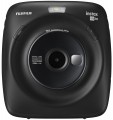Type
— Digital.
Instant digital cameras are equipped with a miniature printer, which prints pictures. Typically, printing is inkjet. Additionally, digital cameras allow you to save pictures to removable flash memory, and many models even know how to record video. The camera's digital interface allows the user to edit pictures before printing. Additionally, such cameras can be equipped with a wireless communication module (Bluetooth, Wi-Fi, NFC), as well as a USB port and a card reader. In general, digital cameras are more capable than analogue models, but they also tend to be more expensive.
— Analogue.
Analogue instant cameras take pictures by developing frames on photographic paper. As such, there is no printer in such devices; in its place is a “mini studio” for developing photographs. Obtaining photographs by developing is inferior in speed to digital printing. If it takes 2-3 minutes to develop a photo, and up to 5-7 minutes in retro cameras, then digital printing prepares a photo for 1 minute or even less. Analogue cameras can be equipped with an LCD screen that displays information about the selected shooting modes, frame reserve, etc.
Picture print time
Printing/developing time is the speed at which photo cards are ready for viewing. The fastest photos are obtained on digital cameras — it usually takes from 10-20 seconds to 1 minute to print one average photo. When working with analogue models, the time for obtaining images increases significantly — on average, the development of an image takes 1-2 minutes. And analogue cameras from the “retro” series can develop pictures for 5-7 minutes at all.
Power source
—
Battery. The camera is powered by a non-removable battery. Battery packs of this type usually use a high charge capacity, which is practically unattainable for ordinary removable AA batteries. The non-removable battery is recharged via the micro-USB port. Among the shortcomings, one can note only the inability to simply replace a dead battery with a pre-charged spare battery.
—
Batteries. The camera is powered by removable batteries. The battery pack is usually designed for 2-4 AA or CR2 batteries. The main advantage of solutions of this type is the ability to quickly replace dead batteries. Additionally, the user has the opportunity to select the optimal capacity of the battery pack. Among the shortcomings, one can only note the lack of the ability to charge batteries directly in the camera — this option is typical only for models with a non-removable battery.
Screen
The display shows information about shooting modes, remaining shots and battery power. The LCD screen makes it easy to navigate through the camera's setup menus. Note that the normal frame counter is not a display.
Card reader
The card reader allows you to use memory cards of various formats in the camera. Typically, the card reader supports the following drives: MicroSD, mini-SD and SD. The presence of a card reader is typical for instant digital cameras. You can save not only pictures, but also videos to the memory card.

